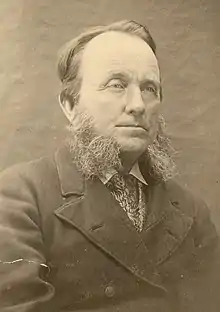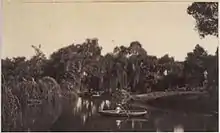Samuel Sweet
Captain Samuel White Sweet (1 May 1825 – 4 January 1886) was an English sea captain who settled in Australia in 1864, and was involved in the early colonization of the Northern Territory. After the grounding of his ships Gulnare and Wallaroo, for both of which he was held culpable, he turned his interest in photography from a serious hobby and part-time occupation to a profession.[1] Sweet was a pioneer of Australian landscape photography as an art form, and kept abreast of technical advances in the medium.[2]
Captain Samuel White Sweet | |
|---|---|
 | |
| Born | 1 May 1825 Portsea, Portsmouth, England |
| Died | 4 January 1886 (aged 60) Riverton, South Australia, Australia |
| Occupation | Photographer & merchant ship master |
| Spouse | Elizabeth Tilly |
Background
Sweet was born in Portsea, a few km inland from Portsmouth, Hampshire, and had only a basic education.
In 1844 Sweet joined the Royal Navy at age nineteen, serving on the China Station until 1849. Sweet gained command of the merchant ship Pizarro in 1857 for which he kept the meteorological log for the Board of Trade for several years. These efforts resulted in Sweet being awarded "Letters of Honorable Mentions". In 1861 Sweet travelled the South American waters carrying out surveys for the charts of the British Admiralty. He married in Portsea and had several children in England. In 1864 Sweet and his family arrived in Queensland, Australia to grow cotton[3] having migrated from England on the Flying Cloud. In 1866 Sweet set up his first photographic practice in partnership with William Gibson. From this time Sweet committed himself to photography and in 1868 applied for the role of the official photographer for the Goyder Northern Territory Expedition, however was instead appointed as Commander of the Government Schooner Gulnare which supported the Goyder Expedition[4] and the new settlement at Port Darwin. Whilst Sweet was never the official photographer of this trip (Joseph Brooks was the appointee), Sweet did take on some of Brooks' photographic duties while he was busy surveying. As a result of this, during his return from the North Sweet organised exhibitions and lectures of his views surrounding the trip and secured sales of his prints through James Williams's Stationery shop. In 1870 Sweet was also commissioned to supply northern construction teams who were building the British-Australian overland telegraph link from Darwin to Port Adelaide. Sweet's views are the only record of this event.[5] At this time he was also commissioned to survey the Roper River. Sweet made five voyages between Adelaide and the Northern Territory between 1869 and 1872, taking photographs alongside managing his main duties.

Schooner Gulnare
Previously a slaver in the Caribbean,[6] the 150-ton two-masted schooner was purchased by the South Australian Government in 1869 and refurbished as the Northern Territory supply vessel, replacing Sea Ripple, which had been condemned as unfit for service.[7] Within a few weeks Sweet had been appointed her commander[8] and left for the Northern Territory.[9] In 1870 Gulnare took the first Government Resident, Bloomfield Douglas, to Port Darwin. She then acted as a Goyder's supply ship. Sweet stayed on as captain and H. R. Marsh, later captain of Flying Cloud, was mate.
- The wreck
Gulnare, under Captain Sweet, left Darwin Harbour for the Roper River at 7am on 5 October 1871, and that same night she ran aground on one of the reefs that surround the Vernon Islands. The Bengal under Captain Hummel set out from Darwin to render assistance on the 10th, and after removing twenty tons of cargo assisted in dragging Gulnare free, and returned to Darwin on the 13th. Gulnare returned to Darwin on the 14th and run onto the beach to have her hull inspected. At an inquiry on 19 October Sweet testified that he was confident that Gulnare was sufficiently seaworthy to return to Adelaide, but the crew had deserted her to work on the Overland Telegraph Line.[10] Sweet insisted that Gulnare could be repaired in a week at most, and could profitably make a return voyage to Adelaide,[11] but she was deemed unseaworthy and abandoned. The Darwin enquiry had no authority to judge Sweet's actions, and at a properly constituted Court of Enquiry held at Port Adelaide on 25 and 26 July 1872, Sweet was found to have been lacking in judgment and censured, but his certificate of competency was returned to him,[12] but he lost his government commission.
He then captained the barque Wallaroo, transporting coal from Newcastle to South Australia.[13] On 11 May 1875 Wallaroo became grounded on Office Beach, Wallaroo during a gale. An inquest attributed the grounding to Sweet's miscalculation, and he was censured for neglect, but again did not lose his ticket.[14] Sweet had already resigned his position with the Black Diamond Line;[15] he retired from the sea and opened a photographic studio in Adelaide,[1] marking the beginning of the most prolific period in his photographic career.[16]
Photography
By 1872 Sweet was an experienced photographer and opened a studio on Flinders Street, Adelaide, later moving to Rundle Street. At his studios Sweet took many portrait photographs but focused mainly on landscapes,[3] travelling around South Australia with a horse-drawn darkroom, taking pictures of the Australian outback and homesteads,[1] some of which were exhibited in Melbourne and Sydney.[3] Sweet became one of the colony's largest documentary photographers during the 1870s through to the early 1880s. He was also one of the first photographers to use the new dry-plate/gelatin process during this time.

On 4 January 1886 Sweet died suddenly due to sunstroke at "Halldale", home of the Hall family, near Riverton, South Australia.
Family
He married Elizabeth "Betsey" Tilly some time before emigrating to Australia; they had five daughters and four sons,[17] including:
- Elizabeth Marie "Lily" Sweet (c. 1854 – 28 October 1955) married John Arundel Anthony on 22 September 1883, died in Queensland
- Annie Emma Sweet (21 January 1857 – 30 May 1950) married William Richard Pybus on 28 September 1880.[18] She was known as a fine singer.
- (third daughter) Rosa Sweet (c. 1859 – 19 February 1952)[19] married William Gibson of Bowden on 11 September 1887, lived at Kingston SE
- (fourth daughter) Violet Sweet (c. 1862 – 24 October 1950) married Edwin James Moody (c. 1862 – 9 September 1938) of Rose Park on 31 October 1888, lived 53 Park Terrace, Hillside[20] (now Ovingham)
- (fifth daughter) May Sweet (21 May 1867 – ) married Jabez Adams of Hamilton, Victoria on 30 March 1898
- (third son) Samuel Darwin Sweet (15 May 1869 – 7 May 1937) married Otena Hocking ( –1957) of Brompton on 14 September 1898[21]
- George Howard Sweet (7 December 1871 – 23 July 1952) married Lily ??; lived in Merredin, Western Australia
Recognition
- In the Northern Territory, Mount Sweet (named by George G. McLachlan, one of Goyder's chief surveyors), Sweet's Lookout (believed to have replaced Litchfield's "Mt. Hunchback")[22] and Sweet Street, Darwin[23] were named for him and Mrs. Sweet.
- A portfolio of his photos, taken in the Adelaide Botanic Gardens, was presented by Richard Schomburgk to the Prince of Wales after being exhibited at the Indian and Colonial Exhibition of 1886.
References
- "Sweet, Samuel White (1825–1886)". Biography - Samuel White Sweet - Australian Dictionary of Biography. Retrieved 16 April 2015.
{{cite book}}:|website=ignored (help) - "Sweet In Adelaide -Part 2". Captain Sweet Online. Retrieved 22 April 2015.
- Cato, Jack. The Story Of The Camera In Australia. p. 110.
- "Sweet's Naval Career-Part 1". Captain Sweet Online. Retrieved 16 April 2015.
- Newton, Gael (1988). Shades Of Light. Australian National Gallery. p. 51.
- "NT Place Names Register: Gulnare Street". NT Government. Retrieved 31 January 2018.
- "The Kapunda Herald". Kapunda Herald And Northern Intelligencer. Vol. V, no. 222. South Australia. 22 January 1869. p. 2. Retrieved 31 January 2018 – via National Library of Australia. Margaret Goyder Kerr, in The Surveyors presumed Gulnare to have been named for the SA town, yet she served in Victoria under that name some five years before her service in South Australia.
- "Local Intelligence". The Border Watch. Vol. 8, no. 554. South Australia. 17 February 1869. p. 2. Retrieved 31 January 2018 – via National Library of Australia.
- "Telegraphic Summary for England". South Australian Register. Vol. XXXIII, no. 6963. South Australia. 3 March 1869. p. 3. Retrieved 31 January 2018 – via National Library of Australia.
- "The Northern Territory". The Evening Journal (Adelaide). Vol. IV, no. 947. South Australia. 12 February 1872. p. 3. Retrieved 31 January 2018 – via National Library of Australia.
- "The Government Schooner Gulnare". South Australian Chronicle And Weekly Mail. Vol. XV, no. 726. South Australia. 13 July 1872. p. 9. Retrieved 31 January 2018 – via National Library of Australia.
- "General News". The Southern Argus. Vol. VII, no. 333. South Australia. 2 August 1872. p. 2. Retrieved 31 January 2018 – via National Library of Australia.
- "Sweet's Naval Career-Part 2". Captain Sweet Online. Retrieved 16 April 2015.
- "Latest News". The Evening Journal (Adelaide). Vol. VII, no. 1997. South Australia. 27 July 1875. p. 2. Retrieved 31 January 2018 – via National Library of Australia.
- "Events of the Month". The Wallaroo Times And Mining Journal. Vol. XI, no. 1055. South Australia. 19 May 1875. p. 1 (Supplement to the Wallaroo Times). Retrieved 31 January 2018 – via National Library of Australia.
- K. Magee. "Capt. Sweet's Colonial imagination" (PDF). Retrieved 31 January 2018.
- "Family Notices". The Express and Telegraph. Vol. XLVIII, no. 14, 229. South Australia. 4 February 1911. p. 1. Retrieved 18 November 2018 – via National Library of Australia. ADB has "four daughters and five sons"
- "Family Notices". South Australian Register. Vol. XLV, no. 10, 575. South Australia. 5 October 1880. p. 4. Retrieved 18 November 2018 – via National Library of Australia.
- "Obituary". The South Eastern Times. No. 4271. South Australia. 29 February 1952. p. 5. Retrieved 18 November 2018 – via National Library of Australia.
- "Family Notices". The Chronicle (Adelaide). Vol. 93, no. 5, 262. South Australia. 26 October 1950. p. 38. Retrieved 18 November 2018 – via National Library of Australia.
- "Family Notices". The Advertiser (Adelaide). South Australia. 24 September 1898. p. 6. Retrieved 18 November 2018 – via National Library of Australia.
- "NT Place Names Register:Mount Sweet". Retrieved 31 January 2018.
- "NT Place Names Register: Sweet Street". Retrieved 31 January 2018.
External links
 Media related to Samuel Sweet at Wikimedia Commons
Media related to Samuel Sweet at Wikimedia Commons